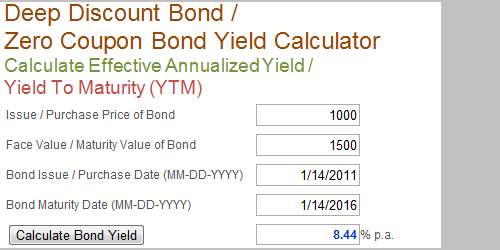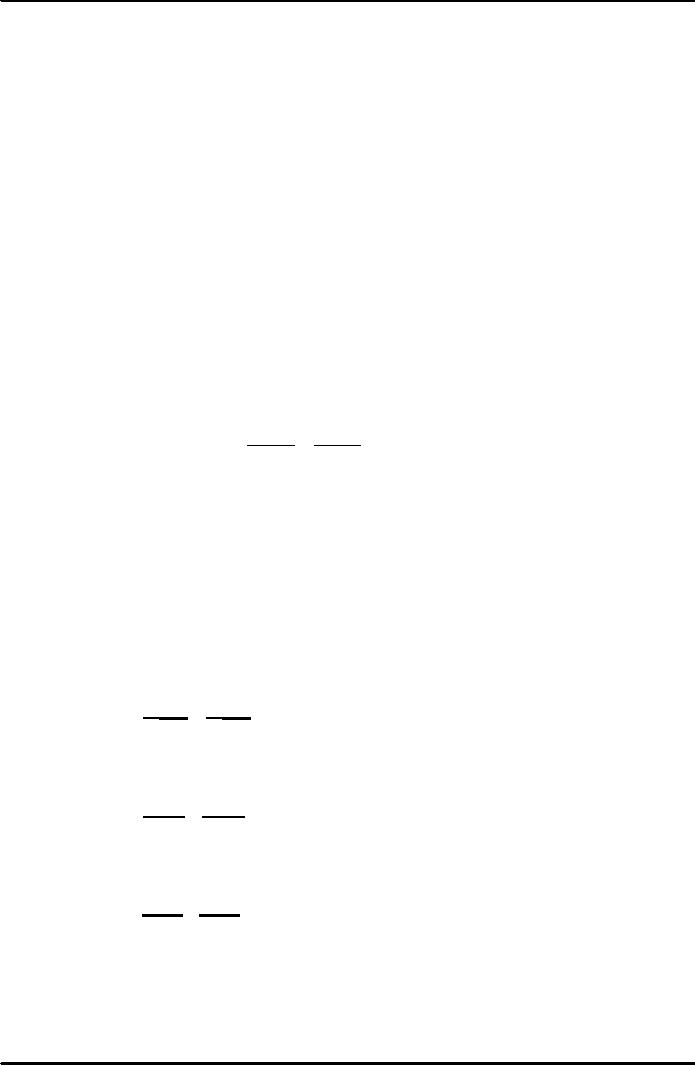42 valuing zero coupon bonds
Bond Valuation Definition - Investopedia Bond valuation is a technique for determining the theoretical fair value of a particular bond. Bond valuation includes calculating the present value of the bond's future interest payments, also ... Advantages and Risks of Zero Coupon Treasury Bonds - Investopedia Zero-coupon bonds are also appealing for investors who wish to pass wealth on to their heirs but are concerned about income taxes or gift taxes. If a zero-coupon bond is purchased for $1,000 and...
Zero-Coupon Bond Definition - Investopedia A zero-coupon bond, also known as an accrual bond, is a debt security that does not pay interest but instead trades at a deep discount, rendering a profit at maturity, when the bond is redeemed for...

Valuing zero coupon bonds
Zero-Coupon Bond Value | Formula, Example, Analysis, Calculator Let's say a $50,000 bond with a 5% coupon rate pays $2,500 in annual interest, irrespective of the bond's current price. However, if the interest rate increases to, say, 7%, the newly issued bonds with a $50,000 face value will pay an annual interest of $3,500. That means the 5% bond is hardly affected by the secondary market. Value and Yield of a Zero-Coupon Bond | Formula & Example - XPLAIND.com Find the value of the zero-coupon bond as at 31 December 2013 and Andrews expected income for the financial year 20X3 from the bonds. Value of Total Holding = 100 × $553.17 = $55,317 Expected accrued income = Value at the end of a period − Value at the start of a period = $55,317 − $50,000 = $5,317 PDF Numerical Example in Valuing Zero coupon Bonds - New York University For example, the value of a zero coupon bond will increase from $385.00 to $620.92 as the bond moves from 10 years to maturity to 5 years to maturity assuming interest rates remain at 10%. 4) Compare the value of the zero at 10 years to maturity when rates are 10% versus when they are 7%. Lower interest rates mean higher bond prices.
Valuing zero coupon bonds. Zero-Coupon Bond: Formula and Calculator [Excel Template] If the zero-coupon bond compounds semi-annually, the number of years until maturity must be multiplied by two to arrive at the total number of compounding periods (t). Zero-Coupon Bond Value Formula Price of Bond (PV) = FV / (1 + r) ^ t Where: PV = Present Value FV = Future Value r = Yield-to-Maturity (YTM) t = Number of Compounding Periods Valuing Bonds - Pace University A pure discount bond, or a zero-coupon bond has a coupon rate of 0%. Any compensation to the bondholder comes solely from the difference between the bond's purchase price and the face value of the bond. ... 10% coupon bond with a $1000 face value. Bond 2: A 2 year, 8.8% coupon bond with a $1000 face value. Bond 3: A 2 year, 8% coupon bond with ... Valuing a zero-coupon bond | Mastering Python for Finance - Packt A zero-coupon bond can be valued as follows: Here, y is the annually-compounded yield or rate of the bond, and t is the time remaining to the maturity of the bond. Let's take a look at an example of a five-year zero-coupon bond with a face value of $ 100. The yield is 5%, compounded annually. The price can be calculated as follows: Valuation Of Zero Coupon Bonds - Otosection Valuation Of Zero Coupon Bonds Youtube The value of a zero coupon bond is determined by its face value, maturity date, and the prevailing interest rate. the formula to calculate the value of a zero coupon bond is. price = m (1 r)n. where: m = maturity value or face value of the bond. r = rate of interest required. n = number of years to maturity.
Zero - Coupon Bonds - Economy Blatt The yield to maturity of a zero - coupon bond is the return an investor can earn from holding the bond to maturity and receiving the promised face value payment. We can determine the yield to maturity of the one - year zero - coupon bond discussed above. 144,927 = 150,000 / (1+ YTM 1) 1 + YTM 1. 1+ YTM 1 = 1.035. YTM 1 = 3.5%. That is ... Zero Coupon Bond Value Calculator: Calculate Price, Yield to Maturity ... Let's say a zero coupon bond is issued for $500 and will pay $1,000 at maturity in 30 years. Divide the $1,000 by $500 gives us 2. Raise 2 to the 1/30th power and you get 1.02329. Subtract 1, and you have 0.02329, which is 2.3239%. Advantages of Zero-coupon Bonds Most bonds typically pay out a coupon every six months. Zero Coupon Bonds Explained (With Examples) - Fervent Zero Coupon Bonds, aka "Deep Discount Bonds", or "ZCBs" are bonds (a type of debt instrument) that don't pay any coupons (aka interest). In other words, there is no coupon payment (aka interest payment). They pay a zero coupon. Hence the name, zero coupon bond. The only thing they do pay is the Par (aka "face value") when the bond matures. How to Calculate Yield to Maturity of a Zero-Coupon Bond With no coupon payments on zero-coupon bonds, their value is entirely based on the current price compared to face value. As such, when interest rates are falling, prices are positioned to rise...
Zero-Coupon Bonds - Acing Finance Valuing Zero-Coupon Bonds. To find the present value of a zero-coupon bond, we take the face value and divide it by the interest rate to the power of time to maturity. The formula is. Where r is the interest rate, and t is the time to maturity. Example: A 3-year zero-coupon bond is issued with a face value of $1000 and an interest rate of 8%. Zero Coupon Bond | Investor.gov Instead, investors buy zero coupon bonds at a deep discount from their face value, which is the amount the investor will receive when the bond "matures" or comes due. The maturity dates on zero coupon bonds are usually long-term—many don't mature for ten, fifteen, or more years. Zero-Coupon Bond - Definition, How It Works, Formula Example of a Zero-Coupon Bonds Example 1: Annual Compounding John is looking to purchase a zero-coupon bond with a face value of $1,000 and 5 years to maturity. The interest rate on the bond is 5% compounded annually. What price will John pay for the bond today? Price of bond = $1,000 / (1+0.05) 5 = $783.53 Zero Coupon Bond Value - Formula (with Calculator) - finance formulas A 5 year zero coupon bond is issued with a face value of $100 and a rate of 6%. Looking at the formula, $100 would be F, 6% would be r, and t would be 5 years. After solving the equation, the original price or value would be $74.73. After 5 years, the bond could then be redeemed for the $100 face value.
How to Calculate a Zero Coupon Bond Price - Double Entry Bookkeeping The zero coupon bond price is calculated as follows: n = 3 i = 7% FV = Face value of the bond = 1,000 Zero coupon bond price = FV / (1 + i) n Zero coupon bond price = 1,000 / (1 + 7%) 3 Zero coupon bond price = 816.30 (rounded to 816)
PDF Numerical Example in Valuing Zero coupon Bonds - New York University For example, the value of a zero coupon bond will increase from $385.00 to $620.92 as the bond moves from 10 years to maturity to 5 years to maturity assuming interest rates remain at 10%. 4) Compare the value of the zero at 10 years to maturity when rates are 10% versus when they are 7%. Lower interest rates mean higher bond prices.
Value and Yield of a Zero-Coupon Bond | Formula & Example - XPLAIND.com Find the value of the zero-coupon bond as at 31 December 2013 and Andrews expected income for the financial year 20X3 from the bonds. Value of Total Holding = 100 × $553.17 = $55,317 Expected accrued income = Value at the end of a period − Value at the start of a period = $55,317 − $50,000 = $5,317
Zero-Coupon Bond Value | Formula, Example, Analysis, Calculator Let's say a $50,000 bond with a 5% coupon rate pays $2,500 in annual interest, irrespective of the bond's current price. However, if the interest rate increases to, say, 7%, the newly issued bonds with a $50,000 face value will pay an annual interest of $3,500. That means the 5% bond is hardly affected by the secondary market.
![[最も人気のある!] yield to maturity formula zero coupon bond 161022-Yield to ...](https://d2vlcm61l7u1fs.cloudfront.net/media/a6d/a6d9a045-4c4d-413c-a5a5-6b37b2d46e5a/phpSMkGD9.png)






![[最も人気のある!] yield to maturity formula zero coupon bond 161022-Yield to ...](https://image1.slideserve.com/2035744/slide12-l.jpg)

![[最も人気のある!] yield to maturity formula zero coupon bond 161022-Yield to ...](https://www.yumpu.com/en/image/facebook/12426614.jpg)




Post a Comment for "42 valuing zero coupon bonds"